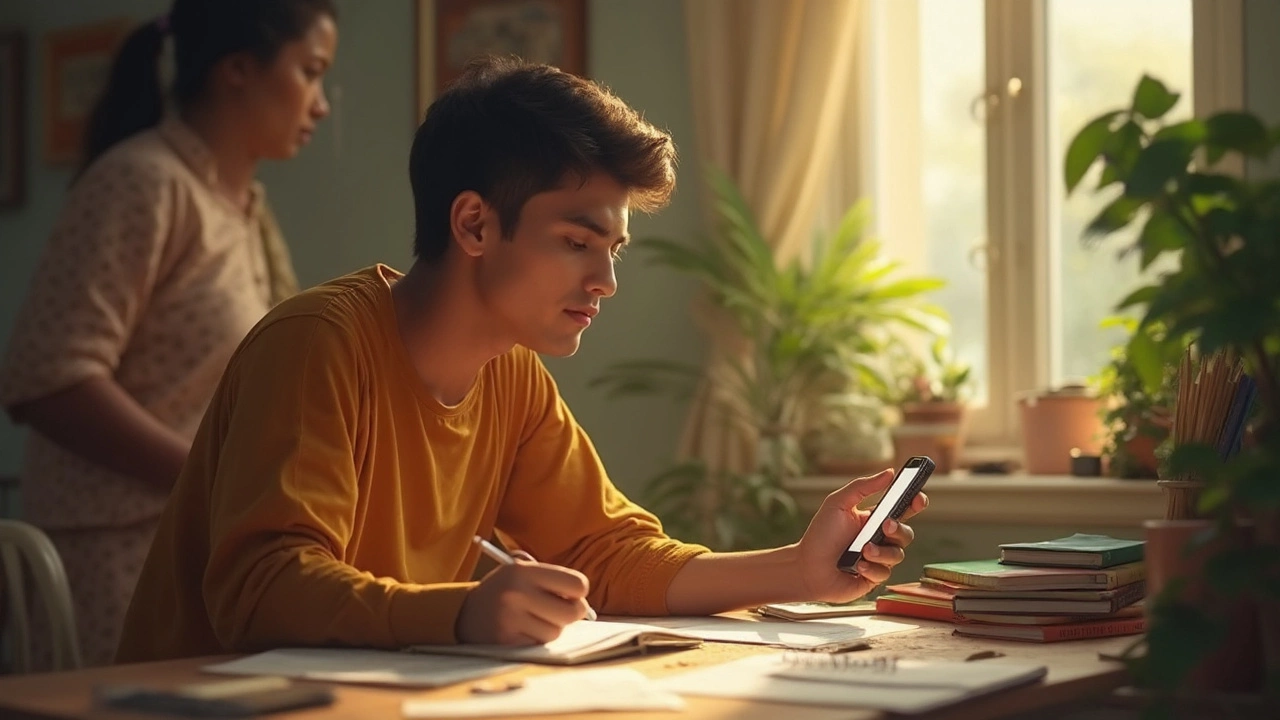Your phone probably spends most of its day in your hand, so why not put it to work for your learning goals? Modern e-learning platforms know you’re always on the move—they design their apps and websites so you can pick up a lesson while waiting for coffee or riding the bus. Big names like Coursera, Khan Academy, and Duolingo have smooth mobile experiences that let you swipe through videos, answer quizzes, or even join live classes with just your thumb.
If you’ve ever dismissed studying on your phone because of the small screen, you’re not alone. But here’s something: a study in early 2024 found that more than 75% of learners used mobile devices for at least half of their coursework. That’s a huge jump from just a few years ago. Phones are no longer just for quick Google searches—they’re solid tools for serious progress, especially if you know a few tricks for keeping distractions at bay.
- Is Phone Learning Really Practical?
- Best eLearning Platforms for Mobile
- Troubles and Quick Fixes
- Tips to Stay Focused and Productive
Is Phone Learning Really Practical?
If you’re still picturing eLearning as something you have to do at a desk with a laptop, you’re missing a big shift. In 2024, mobile traffic made up almost 60% of all online course usage, according to EdTech Magazine. Phones aren’t just a backup—they’re leading the way for a lot of learners, especially for microlearning or bite-sized content.
There are real perks to using your phone for learning. First, it’s always with you, so you can fill in downtime—standing in line, taking the train, waiting for your turn at the doctor’s office. A short 10-minute quiz here, a video lesson there, and it all adds up. This kind of flexibility is why language apps like Duolingo saw over 70% of sessions happen on mobile in 2024.
But let’s get real—phones have some downsides. The small screen makes typing harder for assignments. Battery life can cut into long study streaks. Plus, notification overload can wreck your focus. Some platforms don’t bring their full desktop features to the mobile version, so you might miss advanced tools or projects. Here’s how mobile learning stacks up for common study tasks:
| Task | Mobile | Desktop |
|---|---|---|
| Watching Video Lessons | Great | Best (bigger screen) |
| Taking Quizzes | Easy and Fast | Easy |
| Submitting Essays | Possible, but harder | Way easier |
| Group Discussions | Doable with app chats | More tools available |
If you’re aiming for progress in short bursts, phone learning can be practical. For longer, detail-heavy projects, you’re probably better off at a computer. But for most folks juggling work, family, or commuting, a phone is way more than just a backup plan—it's a handy classroom in your pocket.
Best eLearning Platforms for Mobile
People want something that works the moment they tap the app. That’s why some eLearning platforms are miles ahead when it comes to phones. If you want video courses, discussions, or even coding tasks—there’s an app for that. Here’s what you need to know before picking where to spend your screen time (and maybe your money).
- Coursera - This giant handles more than just boring lectures. Coursera’s mobile app lets you download lessons for offline access, add notes, and even join peer discussions. Got a long commute? Knock out a lecture or quiz without burning mobile data.
- Khan Academy - Famous for its free content and friendly vibe, Khan Academy makes mobile learning easy, especially for students tackling math, science, or history basics. The app tracks your progress and lets you bounce between devices with no headaches.
- Duolingo - If languages are your thing, this app is basically made for your phone. Short lessons, regular reminders, and even friendly competition with your friends keep you hooked without feeling like homework.
- Udemy - You’ll find everything from coding to cooking here. The Udemy app is packed with mobile-friendly features—play videos at any speed, download courses, or even cast lessons to your TV if your eyes get tired.
- LinkedIn Learning - Perfect for career-driven users, this platform handles business, technology, and creativity courses. The app remembers your spot, syncs with your desktop, and lets you display new skills right on your LinkedIn profile.
If you’re into stats, check out the numbers from April 2025 for active mobile learners worldwide:
| Platform | Active Mobile Users (Millions) |
|---|---|
| Coursera | 37 |
| Khan Academy | 18 |
| Duolingo | 30 |
| Udemy | 22 |
| LinkedIn Learning | 12 |
The real trick? Choose a platform that feels right for eLearning in your daily routine—one that loads fast, keeps your spot, and sends helpful nudges without drowning you in notifications. Try a couple out and see which fits your style. It’s way better to enjoy learning than to force yourself through clunky menus and glitchy videos.

Troubles and Quick Fixes
Let’s be real: mobile eLearning isn’t perfect. Glitchy videos, slow downloads, tiny text, and non-stop notifications can wreck your flow. If you’ve ever tried to load a course and just got the endless spinning wheel—yeah, that’s a thing. But most of these headaches have quick solutions once you know where to look.
The biggest roadblocks usually boil down to these:
- Poor internet connection
- Battery drain
- App crashes or freezing
- Too many distractions from other apps
- Eye strain from tiny fonts
Let’s dig into ways to sidestep these pain points:
- Poor internet? Most platforms like Coursera and Udemy let you download lessons or videos while you have Wi-Fi. Watch offline when you’re on the go to save data and avoid lag.
- Battery running low? Lower your screen brightness, close unused background apps, and keep a small power bank handy. Studies show learners with a charger nearby finish 18% more mobile lessons.
- App glitching or freezing? Check for app updates in your phone’s store—most fixes are rolled out every couple of months. If things keep crashing, clearing the app cache usually works wonders, or you can switch to the mobile site for a while.
- Notification overload? Use Focus or Do Not Disturb mode when you’re in a lesson. It’s way easier to stay on track when your phone isn’t lighting up every two minutes.
- Can’t read the screen? Bump up font size in your phone’s settings, or use text-to-speech if the app supports it. Most platforms let you tweak display settings for better comfort.
Here’s a quick look at the most common issues and how often folks run into them, based on a 2024 survey of 1,000 mobile users in online courses:
| Problem | % of Users Affected | Quick Fix |
|---|---|---|
| Poor Internet Connection | 62% | Download materials in advance |
| Battery Drain | 45% | Lower brightness, use power bank |
| App Freezing/Crashing | 38% | Update app, clear cache |
| Distractions (Notifications) | 70% | Use Do Not Disturb mode |
| Text Too Small | 23% | Increase font size, use accessibility tools |
Bottom line? Most hurdles with eLearning on your phone aren’t dealbreakers. A few settings tweaks, a download or two, and you’re set for learning that fits into your pocket (and your schedule).
Tips to Stay Focused and Productive
Staying on task with learning apps isn’t as easy as it looks. With messages, memes, and endless notifications, your phone is built to grab your attention, not keep you focused. But the good news: you can flip those habits around and actually get more done in less time—if you set up your phone right for eLearning.
- Mute notifications before starting. Go into Do Not Disturb mode. Even just thirty minutes without pings can work wonders for deep focus. Studies out of MIT show that turning off notifications increases productivity by up to 20% over a few hours of screen time.
- Set a timer. Try a Pomodoro approach—study for 25 minutes, then take a 5-minute break. You can find dozens of free timers in app stores made just for this.
- Download materials ahead of time. If your app lets you save lessons for offline use, do it. That way, you’re not left hanging when your signal drops or Wi-Fi goes spotty mid-video. Most top mobile learning platforms like Udemy, Coursera, and Skillshare have this option now.
- Stick to just one or two dedicated apps. Too many apps scatter your focus. Pick the ones that feel the most comfortable, and stick with them for a few weeks before switching.
- Use widgets or shortcuts on your phone’s home screen. Putting your learning app up front is a constant reminder and one less tap to get started.
One more underrated hack: keep your phone out of reach when not studying. Leave it across the room during breaks—out of sight, out of mind. Your willpower will thank you.



